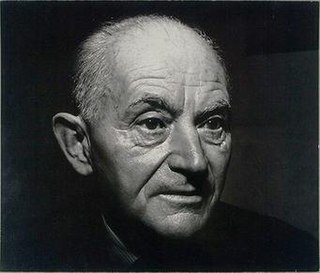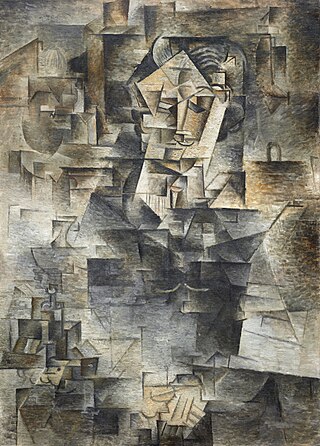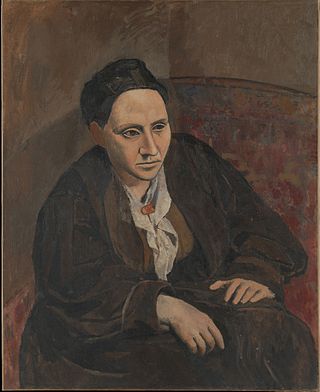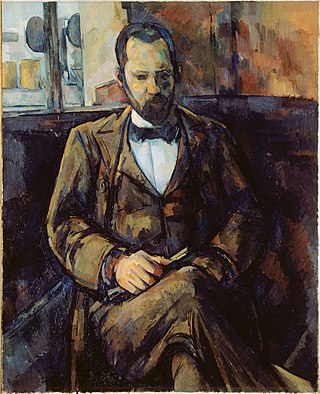
Paul Cézanne was a French Post-Impressionist painter whose work introduced new modes of representation and influenced avant-garde artistic movements of the early 20th century. Cézanne is said to have formed the bridge between late 19th-century Impressionism and early 20th century Cubism.

Pierre-Auguste Renoir was a French artist who was a leading painter in the development of the Impressionist style. As a celebrator of beauty and especially feminine sensuality, it has been said that "Renoir is the final representative of a tradition which runs directly from Rubens to Watteau."

Cubism is an early-20th-century avant-garde art movement that revolutionized European painting and sculpture, and inspired related artistic movements in music, literature, and architecture. In Cubist works of art, the subjects are analysed, broken up, and reassembled in an abstract form—instead of depicting objects from a single perspective, the artist depicts the subject from multiple perspectives to represent the subject in a greater context. Cubism has been considered the most influential art movement of the 20th century. The term cubism is broadly associated with a variety of artworks produced in Paris or near Paris (Puteaux) during the 1910s and throughout the 1920s.

Daniel-Henry Kahnweiler was a German-born art collector, and one of the most notable French art dealers of the 20th century. He became prominent as an art gallery owner in Paris beginning in 1907 and was among the first champions of Pablo Picasso, Georges Braque and the Cubist movement in art.

Les Demoiselles d'Avignon is a large oil painting created in 1907 by the Spanish artist Pablo Picasso. Part of the permanent collection of the Museum of Modern Art in New York, it portrays five nude female prostitutes in a brothel on Carrer d'Avinyó, a street in Barcelona, Spain. The figures are confrontational and not conventionally feminine, being rendered with angular and disjointed body shapes, some to a menacing degree. The far left figure exhibits facial features and dress of Egyptian or southern Asian style. The two adjacent figures are in an Iberian style of Picasso's Spain, while the two on the right have African mask-like features. Picasso said the ethnic primitivism evoked in these masks moved him to "liberate an utterly original artistic style of compelling, even savage force” leading him to add a shamanistic aspect to his project.

Ambroise Vollard was a French art dealer who is regarded as one of the most important dealers in French contemporary art at the beginning of the twentieth century. He is credited with providing exposure and emotional support to numerous then-unknown artists, including Paul Cézanne, Aristide Maillol, Pierre-Auguste Renoir, Louis Valtat, Pablo Picasso, André Derain, Georges Rouault, Paul Gauguin, and Vincent van Gogh.

Jeune garçon au cheval is an oil on canvas painting by Pablo Picasso. The painting is housed in the Museum of Modern Art in New York. It was painted in Picasso's Rose Period from 1905 to 1906, when he was still a struggling artist living in Paris. The painting is a study for a much larger composition that Picasso never completed.

Le pigeon aux petit pois, sometimes referred to as Dove with green peas, is a 1911 oil on canvas painting by Pablo Picasso. It is an example of Picasso's Cubist works and has an estimated value of €23 million. The painting was one of five artworks stolen from the Musée d'Art Moderne de la Ville de Paris on 20 May 2010, which together are valued at €100 million. It has so far not been recovered and its whereabouts remain unknown.

Cubist sculpture developed in parallel with Cubist painting, beginning in Paris around 1909 with its proto-Cubist phase, and evolving through the early 1920s. Just as Cubist painting, Cubist sculpture is rooted in Paul Cézanne's reduction of painted objects into component planes and geometric solids; cubes, spheres, cylinders, and cones. Presenting fragments and facets of objects that could be visually interpreted in different ways had the effect of 'revealing the structure' of the object. Cubist sculpture essentially is the dynamic rendering of three-dimensional objects in the language of non-Euclidean geometry by shifting viewpoints of volume or mass in terms of spherical, flat and hyperbolic surfaces.

The Accordionist is a 1911 oil on canvas painting by Pablo Picasso. The painting portrays a seated man playing an accordion. The division of three-dimensional forms into a two-dimensional plane indicates that the painting is in the style of Analytical Cubism, which was developed by Picasso and Georges Braque between 1907 and 1914. The painting is now in the Solomon R. Guggenheim Museum in New York City.
Bottle, Glass, Fork is an oil on canvas painting by Pablo Picasso (1881–1973). It was painted in the spring of 1912, at the height of the development of Analytic Cubism. Bottle, Glass, Fork is one of the best representations of the point in Picasso's career when his Cubist painting reached almost full abstraction. The analytic phase of Cubism was an original art movement developed by Picasso and his contemporary Georges Braque (1882–1963) and lasted from 1908-1912. Like Bottle, Glass, Fork, the paintings of this movement are characterized by the limited use of color, and a complex, elegant composition of small, fragmented, tightly interwoven planes within an all-over composition of broader planes. While the figures in Bottle, Glass, Fork can be difficult to discern, the objects do emerge after careful study of the painting. The painting is displayed in the Cleveland Museum of Art.

Portrait of Daniel-Henry Kahnweiler is an oil on canvas painting by Pablo Picasso in the Analytical Cubism style. It was completed in the autumn of 1910 and depicts the prominent art dealer Daniel-Henry Kahnweiler, who played an important role in supporting Cubism. The painting is housed in the collection of the Art Institute of Chicago.

Proto-Cubism is an intermediary transition phase in the history of art chronologically extending from 1906 to 1910. Evidence suggests that the production of proto-Cubist paintings resulted from a wide-ranging series of experiments, circumstances, influences and conditions, rather than from one isolated static event, trajectory, artist or discourse. With its roots stemming from at least the late 19th century, this period is characterized by a move towards the radical geometrization of form and a reduction or limitation of the color palette. It is essentially the first experimental and exploratory phase of an art movement that would become altogether more extreme, known from the spring of 1911 as Cubism.

Crystal Cubism is a distilled form of Cubism consistent with a shift, between 1915 and 1916, towards a strong emphasis on flat surface activity and large overlapping geometric planes. The primacy of the underlying geometric structure, rooted in the abstract, controls practically all of the elements of the artwork.
La Coiffeuse is an oil on canvas painting by Pablo Picasso that he created in 1911. It was painted in the early Cubist style, known as Analytical Cubism, which Picasso pioneered. The painting has been valued at $15m (£10m). It was reported as stolen from Paris' Centre Georges Pompidou in 2001, but then recovered in a shipment from Belgium to Newark, New Jersey, in December 2014. It was returned to Centre Pompidou in 2015.

Portrait of Gertrude Stein is an oil-on-canvas painting of the American writer and art collector Gertrude Stein by Pablo Picasso, which was begun in 1905 and finished the following year. The painting is housed in the Metropolitan Museum of Art in New York. It is considered one of the important works of Picasso's Rose Period. The portrait has historical significance, due to the subject's role in Picasso's early life as a struggling artist and eventual commercial success. It also represents a significant transitional step in the artist's move towards Cubism.

Young Girl with a Flower Basket is a 1905 oil on canvas painting by Pablo Picasso from his Rose Period. The painting depicts a Parisian street girl, named "Linda", whose fate is unknown. It was painted at a key phase in Picasso's life, as he made the transition from an impoverished bohemian at the start of 1905 to a successful artist by the end of 1906. The painting is listed as one of the most expensive paintings, after achieving a price of $115 million when it was sold at Christie's on 8 May 2018. It is currently the third highest selling painting by Picasso.

Portrait of Ambroise Vollard in a Red Headscarf is an 1899 oil on canvas portrait by Pierre-Auguste Renoir of his art dealer Ambroise Vollard. The painting represents Renoir's late work period (1892–1919). It is housed in the Petit Palais in Paris.

Portrait of Ambroise Vollard is an 1899 oil-on-canvas portrait by Paul Cézanne of his art dealer Ambroise Vollard. It was bequeathed by Vollard on his death to the Petit Palais in Paris, where it is still housed today. Like many of his portraits, the Portrait of Ambroise Vollard displays the significant role of the subject in Cézanne's life, and specifically, the artist's gratitude for promoting his work and establishing his reputation as an artist.

Famille d'acrobates avec singe is a 1905 painting by Pablo Picasso. It depicts a family of travelling circus performers during an intimate moment. The work was produced on cardboard using mixed media: gouache, watercolour, pastel and Indian ink. It is held by the Gothenburg Museum of Art in Gothenburg, Sweden. The work was painted at a key phase in Picasso's life, as he made the transition from an impoverished bohemian at the start of 1905 to a successful artist by the end of 1906.



















